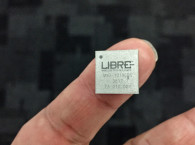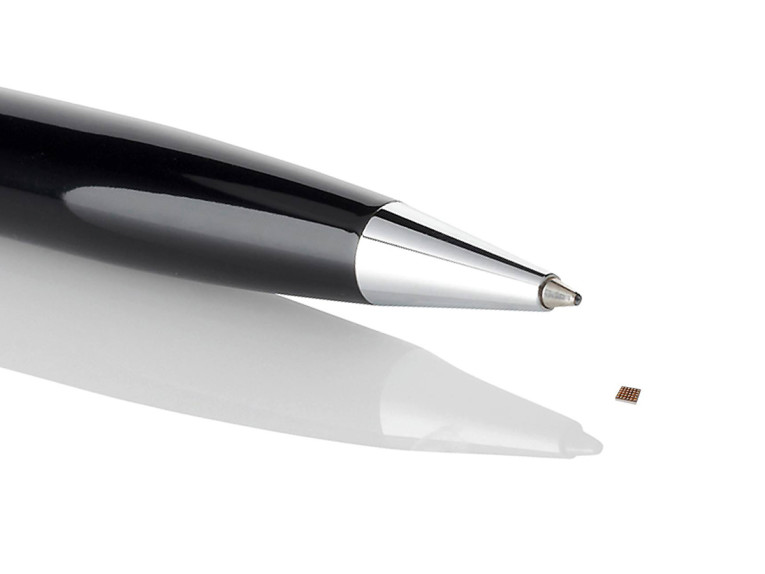
Voice is quickly becoming the preferred method of communication between consumers and their smart devices, and this rise in voice user interfaces (VUI) is changing the way people interact with machines. At the beginning of 2017, 49% of US broadband households were using a personal assistant through an application or dedicated device. Products from Amazon, Google, and Apple have moved voice control into the consumer consciousness, and user expectations are quickly expanding to demand voice as part of all smart device interactions, including wearables.
The US wearable tech market is set to almost double by 2022 as “critical mass adoption” takes place, according to analyst firm Forrester. Wearables will grow from a $4.8 billion industry in 2017 to just over $9 billion in 2022, representing a compound annual growth rate (CAGR) of 9% from 2017 to 2022! With wearables growing in popularity, and consumers preferring to control all smart devices via voice, technology must be designed with communication range, reliability, and energy efficiency in mind.
During the first quarter of 2017, 27% of consumers with a smart speaker and personal assistant reported that they regularly control their smart home devices with this device, and adoption of smart speakers with personal assistants among US broadband households increased 3% from the first to the second quarter of 2017. This increase comes as no surprise as the current generation of tech-savvy consumers often rely on personal assistants and VUI to stay organized when they’re on the go. Consumers want an easy and clear interaction with their devices, making the desire to speak with devices the natural next step.
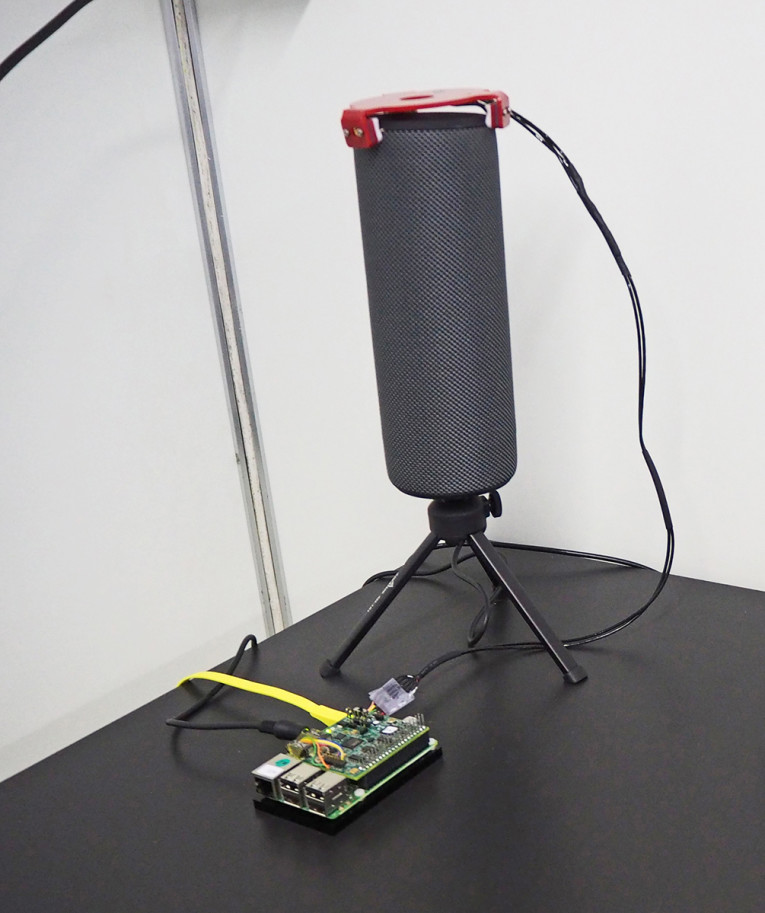
A Chipset Solution
Crisp, natural communication and consistent accuracy has been hard to achieve, but technological developments, such as DSP Group’s DBMDxx family audio system-on-a-chip (SoC) solution, have proven that VUI can attain a comprehensive communication range and an interference-free spectrum band that enables devices to listen at scale.
DSP Group’s DBMDxx audio SoC solution delivers superior voice recognition and processing capabilities, regardless of device distance or ambient noise, by leveraging voice enhancement algorithms, including acoustic echo cancellation, noise suppression, beamforming, and far-field support.
The voice enhancement processing integrated in the DBMD5 chip allows devices to actively listen for the right voice commands and process incoming triggers, enabling clearer communication for the end user and accuracy in high-noise environments. An additional benefit of the technology includes seamless cloud operation enabled by voice-buffer technology, which operates with automatic speech recognition (ASR) applications. Also, its dual-core digital signal processor supports digital and analog microphones that combine a variety of application processor interfaces (e.g., SPI, I2C, UART, GPIO and PCM/ I2S).

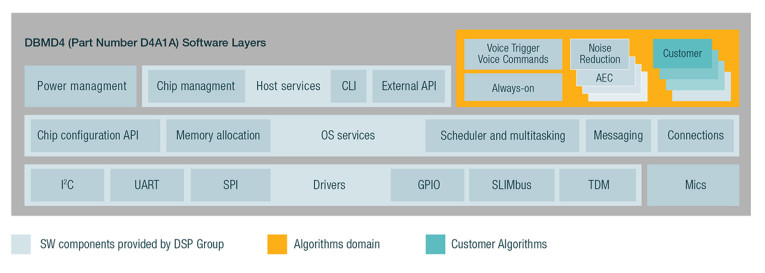
The solution is available in a BGA package (1.8 mm × 2.1 mm) featuring high-speed I2C, UART, TDM, SLIMbus, and SPI interfaces, as well as up to 20 GPIOs. Other features include 32-bit timers/watchdog, interfaces for digital microphone inputs, integrated low power ADC for analog microphone, and JTAG-based debug port. The chipset is complemented with a comprehensive software framework and real-time operating system, with drivers for all processor peripherals, stand-alone master or slave with external master mode option, and an “Internal host” for management and communication with external master processor. The solution provides an easy connection with an external processor running Linux OS with Linux/Android drivers, with Dynamic Power Management.
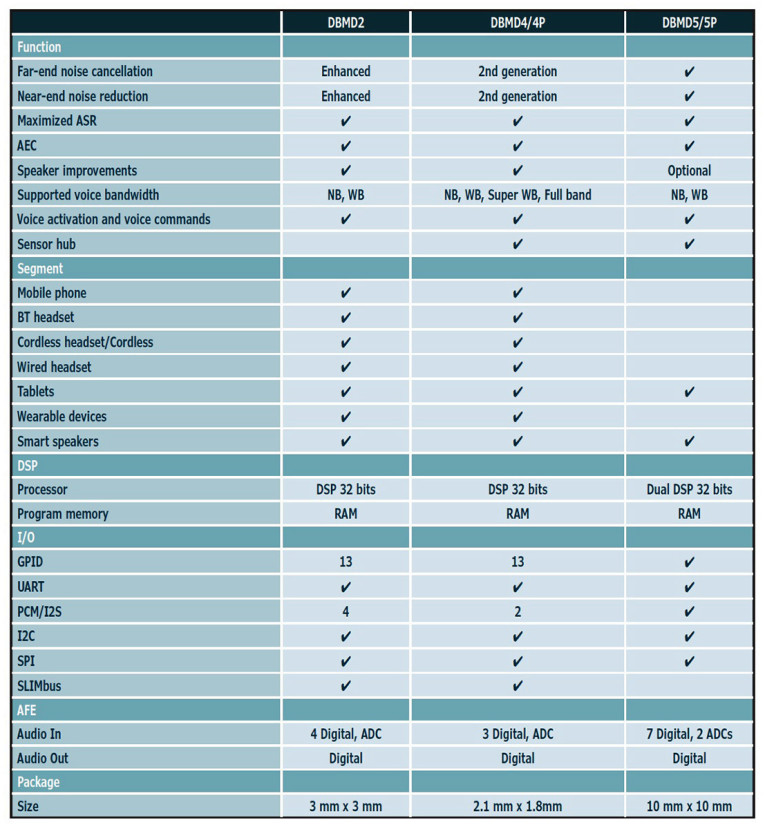
Smart Home and More
In addition to VUI being the preferred mode of interaction for personal assistants on portable devices, over one-third of US broadband households find it appealing to use voice in order to control smart home devices or entertainment devices. Furthermore, 53% of US broadband households that own a smart home device also have a smart speaker with a personal assistant, with only 16% owning a smart home device without a voice-based device in the home. This speaks to the importance of having technology that can enable voice activation to any device, whether it be a smartphone or a speaker, to enable seamless interactions between consumers and their smart home technologies.

Philio-Tech, a company that develops Internet of Things (IoT) products (e.g., network home gateways, temperature control management, intelligent sockets and lighting, and other intelligent home product solutions) is committed to Z-Wave, ZigBee, Ultra-Low Energy (ULE), Wi-Fi, LoRa, and other related technologies that will meet the future needs of the intelligent home. The Philio-Tech voice assistant, which is powered by DSP Group’s ULE and SmartVoice technologies, is a tiny, battery-operated voice-controlled personal assistant that can perform a huge variety of tasks such as checking the weather at a destination you are planning to visit or turning on the lights at home as you arrive. DSP Group’s SmartVoice offering provides the far-field multi-mic noise suppression, barge-in, beam forming and “always-on” voice functionality previously mentioned.
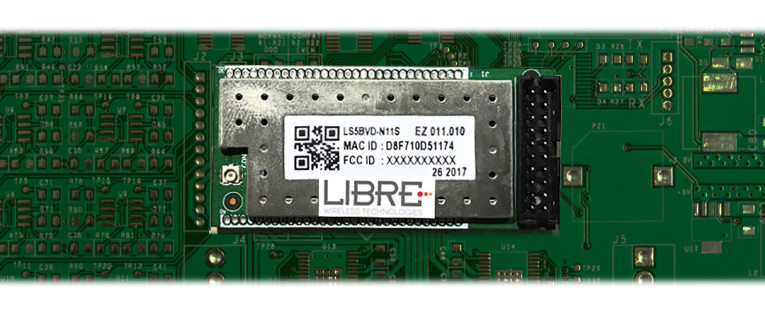
One example of cutting-edge VUI comes from Libre Wireless Technologies. The LibreSync platform incorporates unique media streaming technology, scalable mic-to-cloud voice processing modules and broad mobile platform ecosystem support. In this specific case, Libre is using DSP Group’s SmartVoice technology for its fully integrated LS5BV LibreSync voice and media streaming module. DSP Group’s DBMD5 audio SoC solution helps Libre deliver superior voice recognition and processing capabilities, regardless of device distance or ambient noise, by leveraging voice enhancement algorithms, including acoustic echo cancellation, noise suppression, beam-forming, and far-field support. The voice enhancement processing integrated in the DBMD5 chip enables devices to actively listen for the right voice commands and process incoming triggers, enabling clearer communication for the end user and accuracy in high-noise environments.
iFLYTEK is another company at the forefront of VUI innovation — a leading voice-recognition cloud service provider in China dedicated to the research and development of intelligent speech and language technologies, artificial intelligence, and hardware and software for the government, education, and financial sectors, among other fields. At the core of iFLYTEK’s On-Device Speech Recognition Software is DSP Group’s SmartVoice SoC, which enables easy integration for developers with a substantially shorter development cycle, transforming virtually any device into a voice-activated solution for hands-free control.
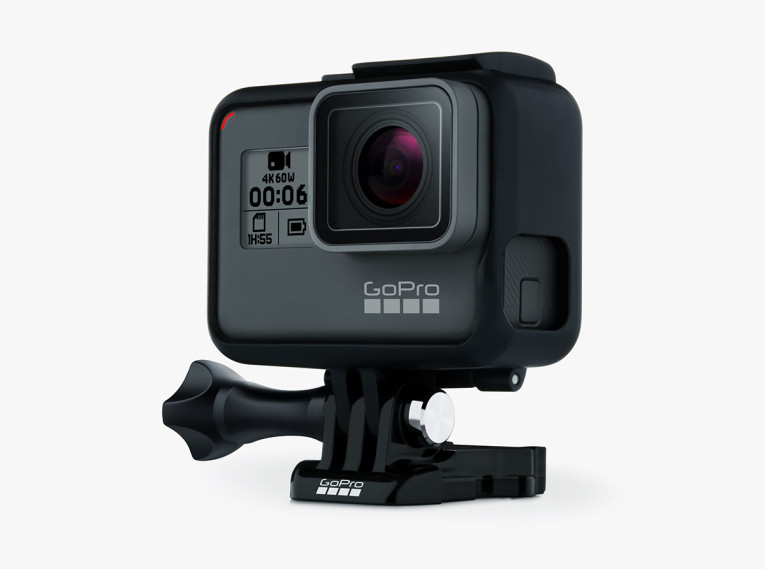
The ULE Alternative
DSP Group’s ULE offering provides several additional benefits, including operation in an interference-free band. ULE operates alone at 1900 MHz, on a dedicated, licensed band, eliminating the chance of crossed signals. The solution’s outstanding range allows covering more than 600 m outdoors—compared to less than 150 m for ZigBee, Z-Wave, and Wi-Fi—with superior indoor coverage moving through walls, ceilings, and floors, when compared to ZigBee.
All communications in ULE are encrypted using AES-CCM, with robust and secure RF channels. There is no un-encrypted mode and no option to switch off encryption as there is in legacy DECT or other technologies. Using a simple star network topology, means there’s no need for repeaters to extend range and reliability. All gadgets and appliances can run from one central hub.
The ULE solution also offers natural support for two-way voice applications. It is ideal for carrying voice wirelessly, and together with the SmartVoice solution, it transforms any device into a voice-enabled product. DSP Group’s ULE and SmartVoice offerings are also both energy efficient, taking up minute amounts of power for always-on functionalities, lasting for years.
The energy efficiency of voice-enabled smart devices is incredibly important because, whether battery or AC-powered, the staggering number of devices and data generated by IoT devices dictate that the electrical power they require be kept at a minimum.
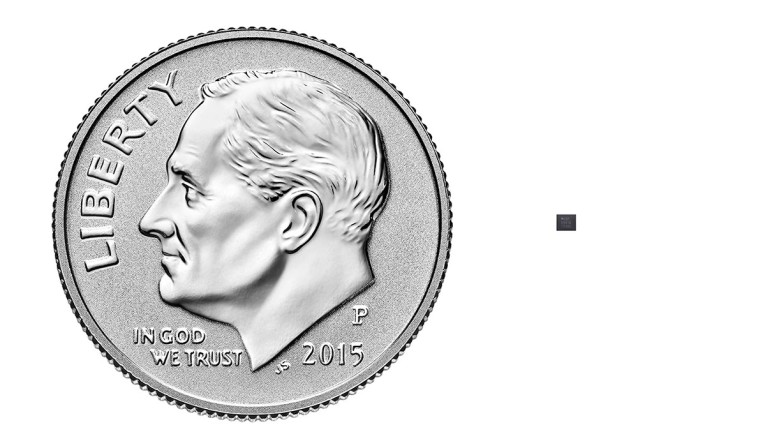
The Low-Power Challenge
The total volume of data generated by IoT devices will reach 600 ZB per year by 2020, and developers require always-on, small form factor, low-energy technologies to tame and channel that data into useful applications.
SmartVoice’s energy-saving capabilities include voice commands that can wake up one portion of a device while keeping other components asleep. These tactics alleviate battery strain and improve device usability, all while maintaining optimal device performance. Technological innovations in the communication range, reliability and energy efficiency of smart devices is why voice-enabled smart gadgets had their biggest year yet. For more information, visit www.dspg.com. aX
Applications
The DBMDxx chipset from DSP Group is currently enabling many smart devices to be controlled by voice, and applications are evolving quickly for all kinds of consumer devices. For example, DSP Group’s DBMDxx chipset is embedded in the latest GoPro Hero 6 camera, which can now respond to its user’s verbal commands. DSP Group’s SmartVoice SoC at the core of GoPro’s latest smart device enables easy integration for developers with a substantially shorter development cycle, transforming virtually any device into a voice-activated solution for hands-free control.
In the past, the quality of smart devices suffered because manufacturers were forced to choose between incorporating either noise isolation capabilities or voice intelligibility, but never both. When deployed on microphone-enabled devices, DSP Group’s SmartVoice solution allows for both capabilities on a single machine, providing a stronger overall user experience for those speaking to their smart devices. DSP Group’s low-power, always-on solution for voice control proves especially important for ensuring that this new functionality doesn’t inhibit GoPro’s biggest selling points, which includes the ability to record handsfree and the ability to keep recording for hours on end.
In addition, the SmartVoice chip’s small footprint enables it to be easily embedded in the small GoPro device, as well as a wide range of devices, including tablets, smart speakers, and other microphone-equipped IoT devices. DSP Group’s SmartVoice technology offers innovative audio and voice processors for many consumer electronics that are used daily by consumers, including smartphones and wearables, in addition to IoT devices.
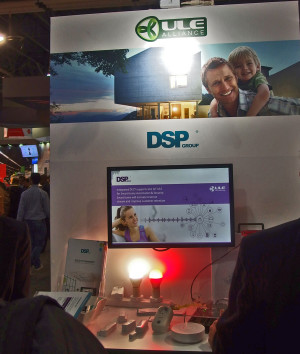 DSP Group and ULE
DSP Group and ULEThe Ultra Low Energy (ULE) Alliance was formed in January 2013 by the DECT Forum, with the support of promoter companies Dialog Semiconductor, DSP Group, Gigaset, Lantiq and VTech. ULE is based on Digital Enhanced Cordless Telecommunications (DECT), which is the de-facto standard for residential and business cordless phone communications worldwide. Its primary goal is to establish ULE Technology as the world’s leading technology for the wireless home and building, promoting the advantages of DECT, such as interference-free connectivity and extended range. The ULE Alliance develops the ULE Certification program, targeted to assure perfect interoperability of different ULE devices, which may be developed by different manufacturers.
ULE addresses ultra-low energy application requirements by introducing optimized communication methods. Identified with low power consumption, low latency, long range, moderate data rate and value-added complementary voice capabilities, ULE Alliance membership has grown quickly reflecting both the technical benefits of the technology and the market interest.
DSP Group meets the growing demand in the Home Area Network (HAN) market for efficient low-power, wireless solutions, supporting the ULE standard. Leveraging its longterm technological and market leadership in DECT applications, DSP Group designed the architecture for ULE and is driving its adoption, enabling development of multi-year, battery-run HAN applications.
DSP Group offers an advanced ULE family of chips, as well as a comprehensive ULE and HAN FUN (Transport and Application layer) protocol, including a low-power chipset solution for home automation and security, equipped with audio capabilities and a powerful ARM processor. DSP Group’s ULE solution is based on its DHAN-S module, which uses its DHX91 chipset and is designed to work easily with even the smallest smart home nodes. The module serves as either a wireless connectivity channel for applications running on an external microcontroller unit, or as a standalone solution with the DHX91 internal ARM926 32-bit processor for smart device hibernation features and voice control support.
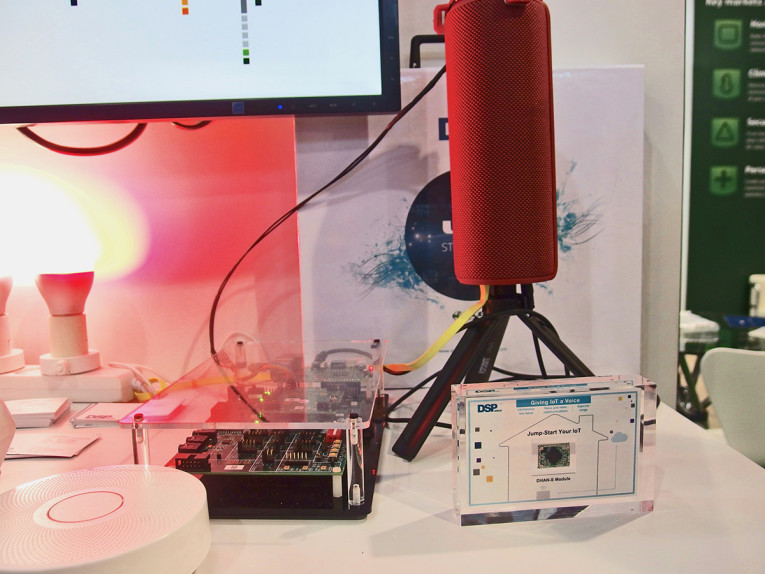
This System-on-a-Chip (SoC) solution has been integrated into many other types of battery-operated nodes, such as smoke and motion detectors, as well as power devices such as AC sockets. The module can serve as a wireless connectivity channel for an application running on an external microcontroller unit (MCU) or can act as a standalone solution using the DHX91’s internal ARM926 processor. DSP Group’s DHAN-S module offers application developers a turn-key platform for ULE applications, whether battery or AC-powered. Built around the company’s DHX91 chipset, DSP Group’s DHAN-S module is easily integrated into the smallest of Smart Home nodes.
The module can serve as a wireless connectivity channel for an application running on an external MCU or can act as a standalone solution using the DHX91’s internal ARM926 processor.
For more information, visit www.ulealliance.org.
This article was originally published in audioxpress, June 2018.
About the Author
 Ofer Elyakim brings more than 15 years of managerial experience to DSP Group. Prior to being appointed to his current position in 2009, Ofer served as DSP Group’s Senior Vice President and SEA President. Before that, Ofer served as Vice President of Business Development and Director of Investor Relations and Business Development. Prior to joining DSP Group in 2006, Ofer was a research analyst covering media and broadcasting companies at CIBC World Markets in New York. Previously, he held managerial positions at Radvision, Tundo Communications, and Kost Forer Gabbay & Kasierer (a member of Ernst & Young Global). A certified public accountant, Ofer holds an MBA with honors from Columbia Business School and a BA in Computer Science and Accounting from Tel Aviv University.
Ofer Elyakim brings more than 15 years of managerial experience to DSP Group. Prior to being appointed to his current position in 2009, Ofer served as DSP Group’s Senior Vice President and SEA President. Before that, Ofer served as Vice President of Business Development and Director of Investor Relations and Business Development. Prior to joining DSP Group in 2006, Ofer was a research analyst covering media and broadcasting companies at CIBC World Markets in New York. Previously, he held managerial positions at Radvision, Tundo Communications, and Kost Forer Gabbay & Kasierer (a member of Ernst & Young Global). A certified public accountant, Ofer holds an MBA with honors from Columbia Business School and a BA in Computer Science and Accounting from Tel Aviv University.





